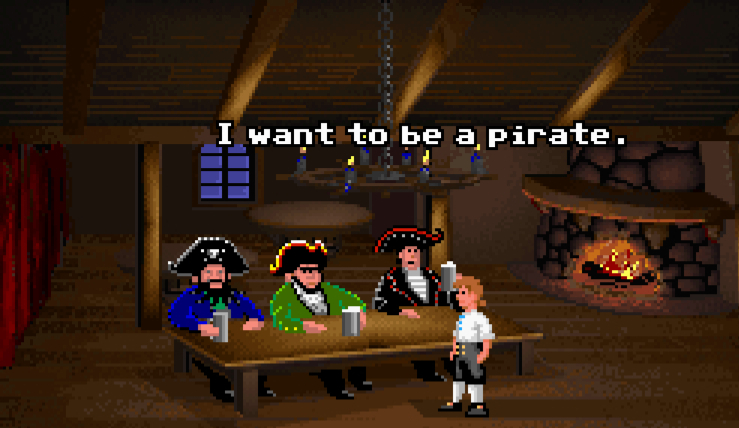One of my favorite games growing up was the Monkey Island series by LucasArts, a swashbuckling, point-and-click adventure game full of challenging puzzles, funny witticisms, and (of course) monkeys. I had been so used to mindless, side-scrolling console games like Super Mario Bros. that finding this mutli-dimensional experience was eye-opening. The possibilities seemed endless! It’s hard to believe this game is already 25 years old, yet the gameplay and cultural references still hold up.

The high level of interactivity with the environment is a hallmark of LucasArts games. Hovering over areas on the screen will prompt you to look at certain items or talk to certain people, gathering information to achieve your goals (like trying to become a pirate). You’re also encouraged to explore every corner of the universe as information from one area will help solve puzzles in another area. You’re also forced to think more expansively about the items in your inventory and improvise where necessary. At one point you’re asked to produce a helmet. Luckily, a cooking pot works just as well in a pinch. Moreover, you can also combine items to create something wholly new. For example, you’ll often need to create potions in the series by acquiring and combining several ingredients.
You’ll soon find that while playing these games, you’ll be developing a very specific set of skills, like problem-solving and persistence. If you’re ever stuck on a puzzle and aren’t sure what to do next, you will inevitably try every combination of inventory items to generate some new ideas or talk to everyone in all possible permutations to garner new information. This speaks to the notion of the adjacent possible, the idea that one can review all of the current possibilities and constraints of a specific topic and determine the immediate first-order steps to take. In his book Where Good Ideas Come From, Steven Johnson describes this process as a “map in which the present can reinvent itself” capturing “both the limits and the creative potential of change and innovation.” He cites the example of Apollo 13, where a team of engineers had to improvise and build a carbon dioxide filter using only the available inventory on the lunar module. This spirit of curiosity and experimentation permeates the entire Monkey Island series.
The act of tinkering with commonplace items can give the player a sense of reawakening, turning the mundane into the novel. This hearkens to Tolkien’s idea of Recovery, “seeing things as we were meant to see them”. The poetic language in The Lord of the Rings enchants the reader, bringing meals, journeys, and nature to life. This explains why stories like his tend to be re-read. While our daily routines force our environment to become “blurred by familiarity”, these adventures help us regain “a clear view”.
The ability to connect different experiences in Monkey Island also brings to mind Einstein’s idea of combinatorial play which Einstein deemed “the essential feature in productive thought”. Combining and recombining ideas tends to reveal unknown connections. This creative state of play happens before any logical construction occurs. As my old Trivium professor used to say, “Pooka doesn’t do windows”. In other words, the process of inspiration and actually connecting the dots are different. Playing the Monkey Island series certainly brings that idea to the forefront.
The Monkey Island series is an enjoyable ride, both thought-provoking and funny. It also helps the player develop skills necessary for creativity and innovation. The series stands in stark contrast with the popular games of today, which overwhelm with cinematic spectacle but usually fall short on engaging the whole person. I’m looking forward to re-playing the series with my son.